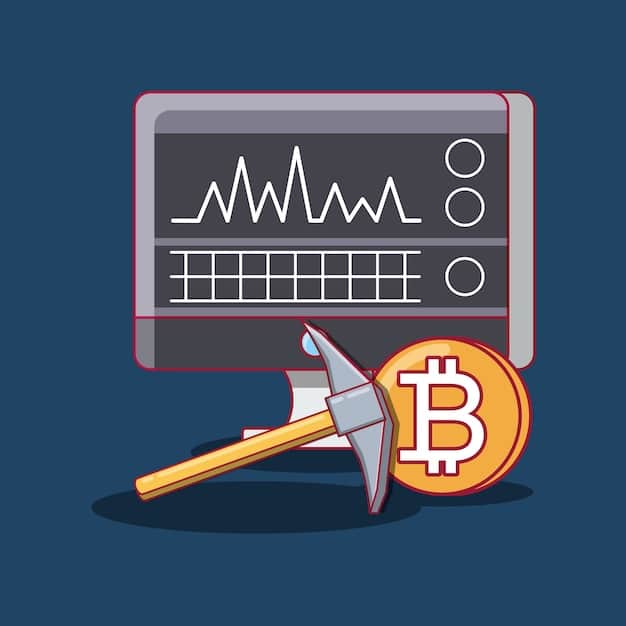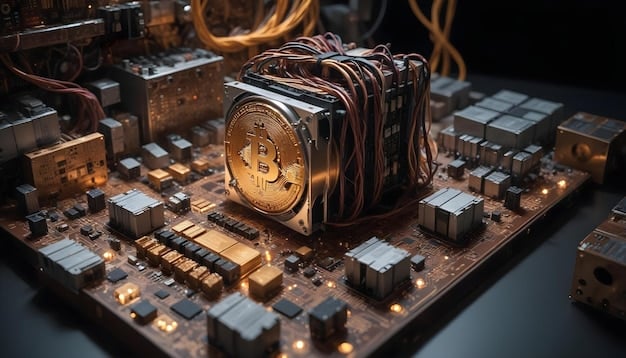Altcoin Mining Profitability in 2025: Energy vs. ROI

Altcoin mining profitability in 2025 hinges on a delicate balance between energy consumption and return on investment, influenced by factors such as cryptocurrency prices, mining difficulty, hardware efficiency, and electricity costs.
Navigating the world of altcoin mining can be complex, especially when weighing energy consumption against potential profits. This article delves into the key factors influencing altcoin mining profitability in 2025, providing valuable insights for miners looking to optimize their operations and maximize returns.
Understanding Altcoin Mining Fundamentals
Altcoin mining is the process of validating cryptocurrency transactions and adding new blocks to a blockchain network, earning the miner a reward in the form of newly created altcoins and transaction fees. Understanding the fundamentals of this process is crucial for assessing potential profitability.
What is Altcoin Mining?
Altcoin mining involves using specialized hardware to solve complex cryptographic puzzles, thereby verifying transactions and securing the network. This process requires significant computational power and, consequently, substantial energy consumption.
Proof-of-Work and Its Impact
The Proof-of-Work (PoW) consensus mechanism, used by many altcoins, requires miners to compete to solve these puzzles. The first miner to find a solution adds the new block to the blockchain and receives the reward. This competitive environment drives the demand for more efficient mining hardware and contributes to the overall energy footprint of altcoin mining.
- Computational Power: Higher hash rates increase the chances of solving the puzzles.
- Energy Consumption: More powerful hardware consumes more electricity.
- Mining Difficulty: The difficulty adjusts to maintain a consistent block creation rate.
Successfully navigating altcoin mining in 2025 will require a deep understanding of these fundamental principles and strategic decision-making.
Key Factors Influencing Profitability
Several key variables determine whether altcoin mining is profitable for miners. These factors include the price of the altcoin, the mining difficulty, the cost of electricity, and the efficiency of the mining hardware.
Altcoin Price Volatility
The price of an altcoin is a major determinant of mining profitability. Higher prices mean greater revenue for miners, while lower prices can lead to losses, especially if the cost of mining exceeds the value of the mined coins. Price volatility adds another layer of complexity, as miners must manage the risk of price fluctuations.
Mining Difficulty and Network Hashrate
Mining difficulty adjusts based on the network hashrate to maintain a consistent block creation time. A higher hashrate means more miners are competing, leading to increased difficulty and reduced individual rewards. Lower hashrate means the opposite.

- Network Effect: A larger network typically translates to higher hashrate and difficulty.
- Competition: More miners increase competition, lowering individual profitability.
- Algorithm Changes: Some altcoins implement algorithm changes to counteract ASIC mining, potentially affecting profitability.
These factors interact dynamically, requiring miners to stay informed and adapt their strategies accordingly.
Energy Consumption: A Critical Consideration
Energy consumption is a major cost factor in altcoin mining and a growing concern for miners and environmental advocates alike. The amount of electricity consumed directly impacts the bottom line and the sustainability of mining operations.
Measuring Energy Efficiency
Energy efficiency in mining is typically measured in terms of hashes per watt (H/W). This metric indicates how much computational power a mining device can deliver for each unit of energy consumed. Higher H/W values represent greater efficiency and lower operating costs.
Hardware Options and Power Usage
Various hardware options are available for altcoin mining, each with its own power consumption characteristics. Application-Specific Integrated Circuits (ASICs) are typically the most efficient, but they are designed for specific algorithms and may not be suitable for all altcoins. Graphics Processing Units (GPUs) offer more flexibility but are generally less energy-efficient.

- ASICs: High hash rates, but limited algorithm support.
- GPUs: More versatile, but less energy-efficient.
- CPUs: Low hash rates, generally unprofitable for mining.
For competitive altcoin mining in 2025, focusing on energy efficiency is essential for maximizing profitability and reducing environmental impact.
ROI Analysis: Projecting Profitability in 2025
Return on Investment (ROI) is a crucial metric for evaluating the financial viability of altcoin mining ventures. Projecting ROI requires careful consideration of all relevant costs and potential revenues, as well as assumptions about future market conditions.
Calculating Mining ROI
To calculate ROI, one must estimate the initial investment (hardware, setup costs), ongoing operational expenses (electricity, maintenance), and expected revenue from mining rewards. The ROI is then calculated as (Revenue – Costs) / Initial Investment.
Variables in ROI Projections
Several variables can impact ROI projections, including altcoin price fluctuations, changes in mining difficulty, variations in electricity costs, and the lifespan of mining hardware. Accurate ROI projections require realistic assumptions and sensitivity analysis.
Creating a detailed financial model that accounts for these variables is critical for making informed investment decisions and assessing the potential risk and reward associated with altcoin mining.
Strategies for Maximizing Mining ROI
To maximize mining ROI, miners should implement strategies that optimize energy efficiency, reduce operating costs, and mitigate risks associated with price volatility and mining difficulty.
Optimizing Hardware and Cooling
Selecting the right hardware and implementing effective cooling systems can significantly improve energy efficiency. Consider using immersion cooling or optimized air cooling to reduce energy waste and extend the lifespan of mining equipment.
Electricity Rate Optimization
Miners can reduce operating costs by seeking out locations with low electricity rates or exploring alternative energy sources such as solar or wind power. Negotiating favorable electricity contracts or participating in demand response programs can also help lower costs.
- Location Selection: Choose areas with low electricity costs.
- Renewable Energy: Consider solar or wind power for sustainability.
- Energy Management: Implement strategies for energy conservation.
Adopting these strategies can help miners achieve higher ROI and maintain a competitive edge in the dynamic altcoin mining landscape.
Future Trends in Altcoin Mining
The future of altcoin mining is likely to be shaped by technological advancements, regulatory developments, and evolving market dynamics. Staying informed about these trends is crucial for miners looking to adapt and thrive.
Emerging Mining Technologies
New mining technologies, such as more energy-efficient ASICs and advanced cooling solutions, will continue to drive improvements in mining efficiency. Quantum computing and other emerging technologies could also disrupt the mining landscape in the long term.
Regulatory Landscape and Impact
Regulatory developments related to cryptocurrency mining, particularly regarding energy consumption and environmental impact, could significantly affect mining operations. Miners may face increasing pressure to adopt sustainable practices or relocate to jurisdictions with more favorable regulations.
By preparing for these future trends, miners can position themselves to take advantage of new opportunities and navigate potential challenges in the evolving altcoin mining industry.
| Key Metric | Brief Description |
|---|---|
| 💰 ROI Calculation | (Revenue – Costs) / Initial Investment, crucial for assessing profitability. |
| ⚡ Energy Efficiency | Measured in hashes per watt (H/W), impacting operational costs. |
| ⛏️ Mining Difficulty | Adjusts with network hashrate, affecting individual miner rewards. |
| 📈 Altcoin Price | High volatility directly influences mining revenue and profitability. |
Frequently Asked Questions
▼
Altcoin price, mining difficulty, energy costs, and hardware efficiency are key. High price and efficient hardware boost profits, while high difficulty and energy costs reduce them.
▼
Energy efficiency is measured in hashes per watt (H/W). Higher H/W values indicate more computational power for each unit of energy consumed, improving profitability.
▼
Options include ASICs (most efficient for specific algorithms), GPUs (more versatile but less efficient), and CPUs (generally unprofitable). Choose based on the altcoin’s algorithm and energy efficiency.
▼
Miners can seek locations with low electricity rates, explore renewable energy sources, negotiate favorable contracts, or participate in demand response programs to lower their costs.
▼
Emerging mining technologies (more efficient ASICs), regulatory developments (environmental impact focus), and market dynamics (altcoin adoption) will shape the mining landscape.
Conclusion
As we look towards 2025, the altcoin mining profitability landscape remains a complex interplay of factors. By focusing on energy efficiency, optimizing ROI, and staying informed about future trends, miners can position themselves for success in this dynamic and evolving industry.





